by Amineddoleh & Associates LLC | Oct 17, 2023 |
Wildfires blazed around the world this past summer with alarming intensity. The world is still feeling the effects of gigantic fires and toxic wildfire smoke. Experts continue to work to understand the impacts of these massive fires, particularly for areas that suffered multiple fires. Further complicating matters, many of these sites relied on tourist dollars for their economy. This makes the re-opening of sites (such as West Maui and specified areas on the Hawaiian west coast) fraught for local communities. Residents and government officials alike strive to balance welcoming tourists with a smile and processing their own grief and loss.
Hawaii was not the only place that suffered from wildfires. Greece, Croatia, Italy, Canada and Algeria all faced massive wildfires that obliterated homes, destroyed nature reserves, and threatened precious cultural heritage. In July, fires in Italy destroyed cultural heritage in Sicily’s Santa Maria de Gesù church. A wooden statue of the Blessed Virgin Mary and the remains of St. Benedict the Moor were both completely destroyed. That same month, additional fires on Spain’s Canary Islands forced evacuations of nearly 30,000 people, listed as two of UNESCO’s World Heritage Sites. With so much art, architecture, nature reserves, and other pieces of international heritage in danger, it’s almost as if the wildfires were specifically targeting culturally protected areas.
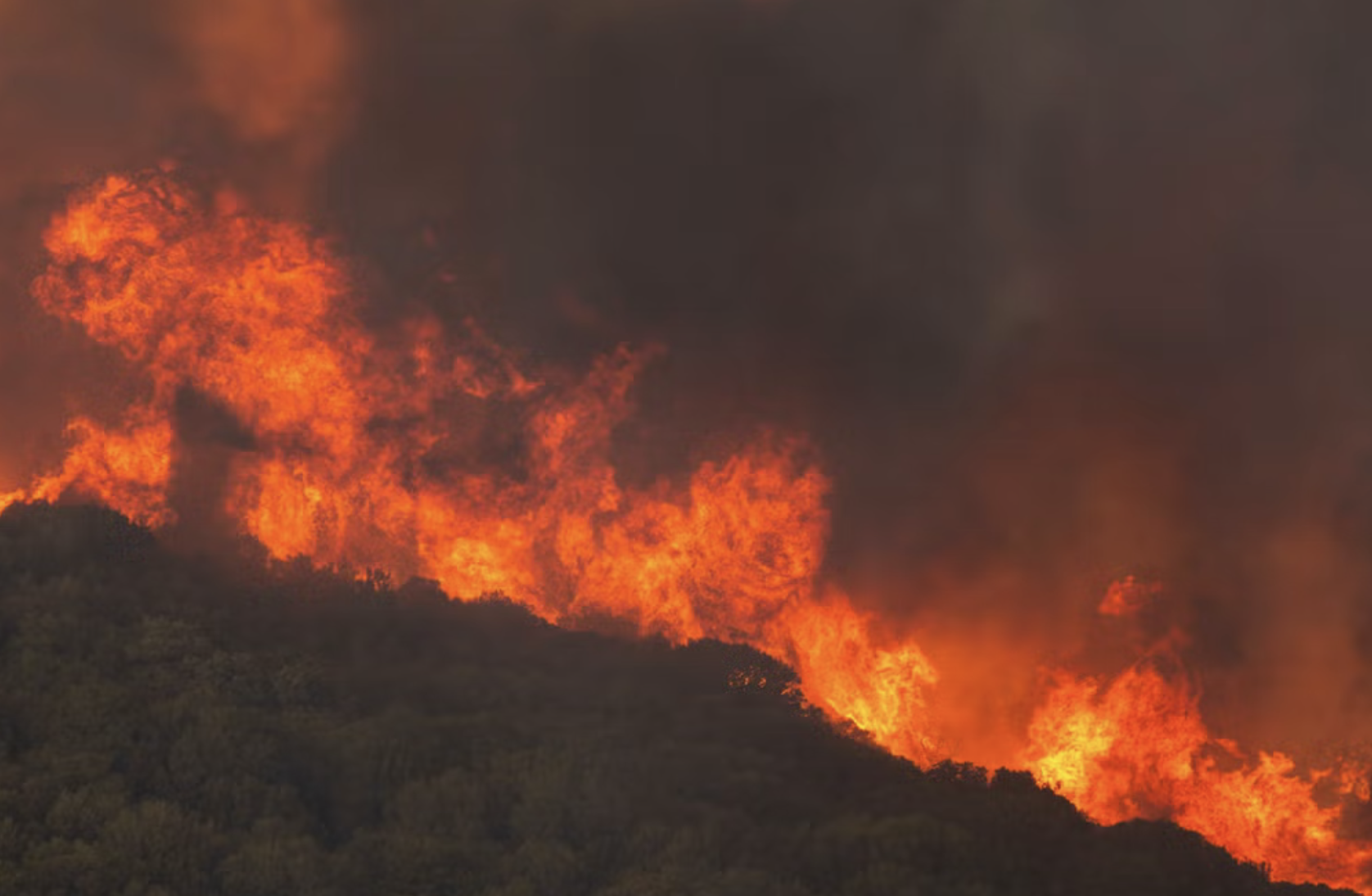
Wildfire burning in northern Greece. Image via Associated Press
Where did these fires coming from? Some say that unusually high temperatures and strong winds literally fanned the flames of some of the worst wildfires seen in decades. In addition to the devastating loss of lives and livelihood, vulnerable pieces of cultural heritage were severely damaged.
Now that the fires are no longer burning, cultural heritage experts around the world are able to identify scorched areas and initiate restoration efforts. Experts also pose this question: how to prevent such destruction by wildfire in the future? Especially when most of the world seems to take an ad hoc approach to cultural heritage restoration following natural disaster?
Greece
One of the hardest-hit areas was Greece. In August, Europe’s biggest wildfire in a century burned in northern Greece.
The fire covered an area larger than New York City, spanning 312 square miles. (For reference, New York City’s solid ground measures 302.6 square miles). Flames from this fire in northern Greece – primarily covering the regions of Evros, Rodopi, Alexandropoulis, Dadia, and northwestern Athens – proved devastating. The flames eradicated housing, farmland, and most of a national forest. In Evros, many took part in forced evacuations but, tragically, many lives were lost to the fires.
In early August, shocking damage occurred on the Grecian island of Rhodes. Satellite images showed Rhodes as a black scar of extensive damage. Evacuations in response to the flames forced thousands of residents to flee their homes and tourists to abandon their accommodations. The evacuations also prevented tourists from visiting cultural heritage hotspots that the island is known for. Namely, its legendary medieval village – a storied and mysterious acropolis built by crusaders within 4-km-long medieval stone walls.
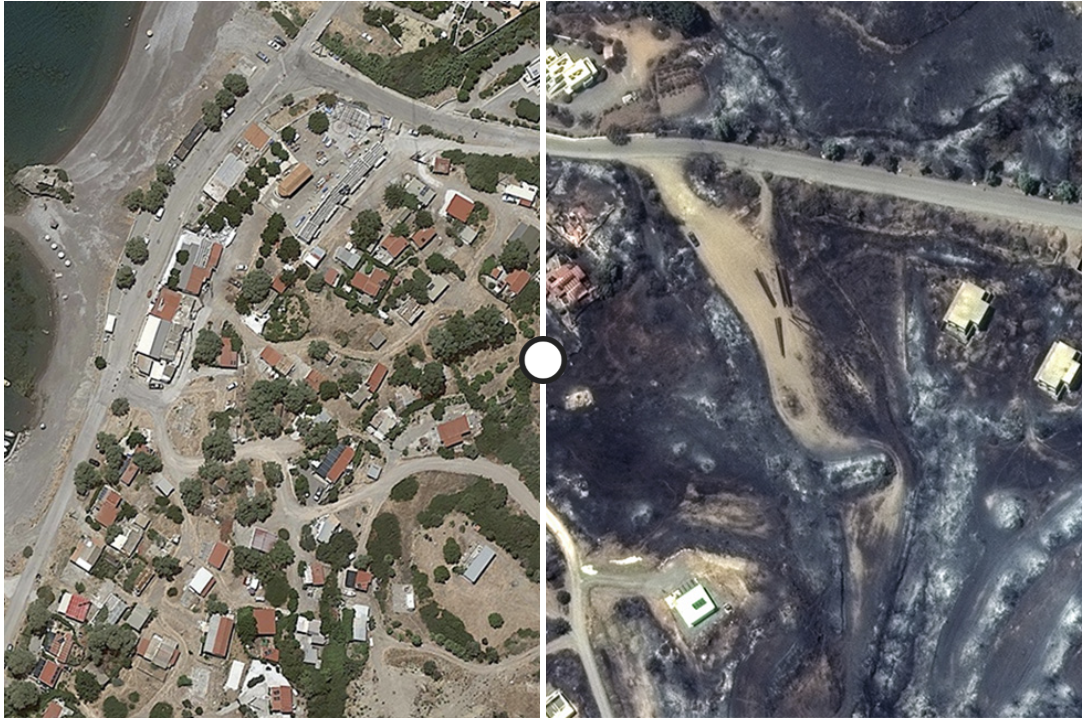
Side-by-side aerial photos of Rhodes, Greece takein in 2019 (left) and 2023 (right). Image via BBC News.
From the beginning, this medieval town has been imbued with legends and dreams of glory. According to the island’s history, Rhodes was transformed into a fortified city by the Knights of St. John of Jerusalem in 1309. The Knights’ occupation was so strong, in fact, that they held the island until 1523 – surviving several takeover attempts by Turkish and Egyptian conquerors.
Military prowess aside, the Knights outdid themselves in terms of city planning. Once on the island, rather than destroying the “ancient core” of the place (which was a perfect grid – the product of 408 B.C., Hippodamian-style city planning), the Knights incorporated their plans for a fortified center as an extension of the ancient design. They further divided the town into a northern quarter, called the “Chateau,” and a southern quarter, called the “Ville.” The Chateau was where the Knights would hang out in their personal residences. They also made sure to stop by the palace of the Grand Master of the Order, which was bigger and fancier than their own abodes. Additionally (and likely for their own convenience), the Knights also made sure that all of the administrative buildings, hospital, and cathedral were located in the northern end. The Ville, in contrast, housed the laity. It’s also where the synagogues and other churches were constructed, as well as the noisy (and predictably odorous) public street market.
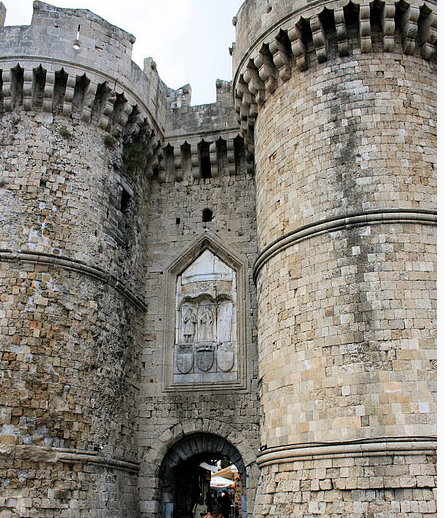
Medieval City of Rhodes. Image by Olbertz via Wikipedia.com.
When the Knights constructed these buildings, they went all-out in terms of style. Gothic and Renaissance designs, with a hint of Ottoman influences and a touch of Byzantine detail, manifested in a sensational conglomeration of art and architecture. Some of the buildings originally constructed as churches were later converted to mosques. Of the sacred spaces that remained churches, Agia Triada (the Holy Trinity), Agios Athanasios (St. Athanasius), Agia Alkaterini (St. Catherine), and Panagia tou Kastrou (the Virgin of the Castle), house gorgeous pieces of art and cultural heritage. The church of Agia Triada, for example, boasts stunning, original frescos. Sections of the fresco depict scenes from Ezekiel’s prophetic visions in the Bible. Other portions illustrate powerful images of Jesus’s Crucifixion on the Cross. And those frescos only scratch the surface in any tourist’s quest to discover the cultural heritage on this illustrious island.
Thankfully, the fires on Rhodes were eventually contained. Damage reports following the fires in Greece allowed cultural heritage to assess where restoration efforts would be needed. Inspections by the Climate Crisis and Civil Protection Ministry teams revealed the status of various architectural structures on-site. On Rhodes, six buildings were been designated by officials as unsafe for use. Twenty-two additional buildings were declared temporarily unfit, and seventeen others have been flagged as needing minor repairs.
The worst damage on Rhodes seems to have occurred in the local areas containing homes, hotels, businesses, and nature reserves. In fact, more than fifty homes, several popular resorts, and over 50,000 olive trees – a source of income for locals – were completely destroyed. Religious sanctuaries also suffered. The Monastery of Panagia Ipseni, in particular, became a verifiable inferno. The monastery’s olive orchards, vineyards, and religious icon workshop (all of which provided additional income for the monastery) were destroyed by the fire. The nuns – thankfully – were spared, yet had to endure watching their home erupt in flames, and their beautiful mosaic courtyard disappear under a layer of soot and ash.
However, the medieval city of Rhodes emerged relatively unscathed – possibly due to location and sheer luck. Even so, it is essential to acknowledge that, for Rhodes’ cultural heritage, escaping total destruction by wildfire was a very narrow victory. Moreover, even minor, “cosmetic” damage to ancient structures by wildfire smoke and extreme temperatures causes deterioration. The charred buildings, such as those seen in Lindos, indicate extensive damage to architecture. Extreme elements threaten to accelerate natural deterioration of delicate art within the medieval city. This alone poses increased dangers for those wishing to preserve Rhodes’ storied history. Restoration and preservation work must be given funding when rebuilding the city from the ashes in order to maintain Rhodes as a cultural heritage destination. Additionally, Grecian officials should consider enacting proactive measures geared toward cultural heritage, as well as putting in place orchestrated fire response protocols. Proactive preservation and planned response teams may save the day if this delicate art and architecture is threatened by natural disaster again.
Croatia
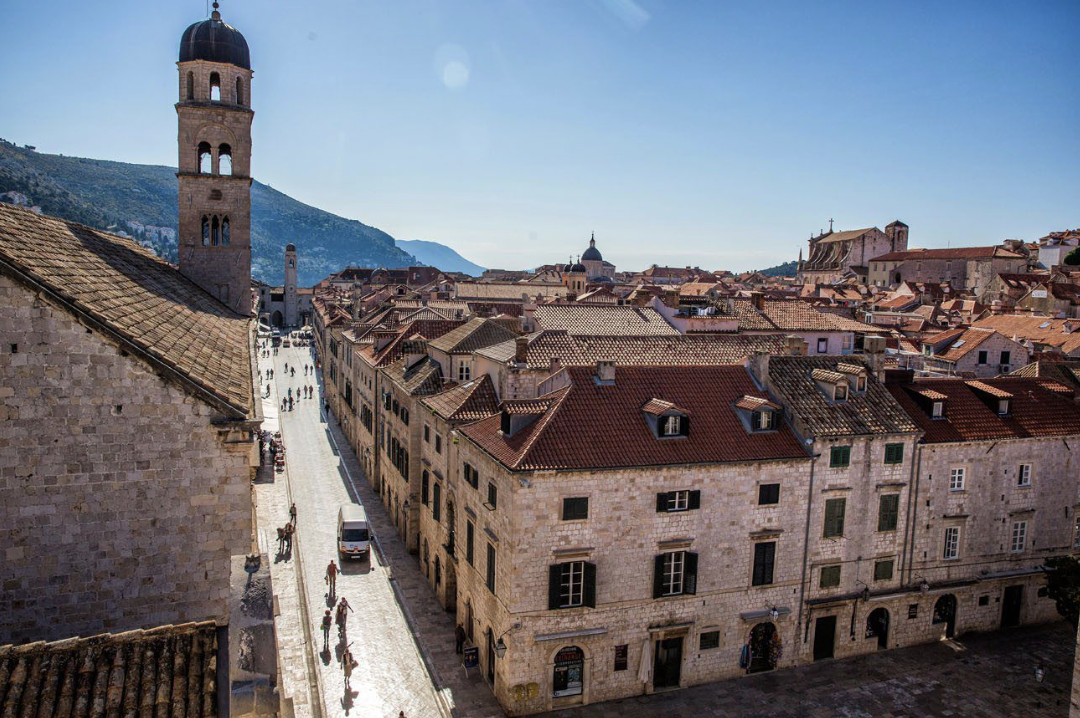
The Dubrovnik Walls in Croatia. Image via earthtrekkers.com.
Croatia’s stunning city of Dubrovnik marks a second European medieval town that narrowly escaped complete destruction of cultural heritage by wildfire this summer. Those lucky enough to have visited Croatia known that Dubrovnik houses vast artistic and architectural treasures. The Old City of Dubrovnik, referred to as the ‘Pearl of the Adriatic’, is listed as one of UNESCO’s World Heritage Sites. Dubrovnik emerged as a powerful city on the Dalmatian coast in the 13th century. The resulting influx of financial wealth produced a city that is a true jewel of art and artistry: Dubrovnik acts as guardian for an array of stunning churches, monasteries, palaces, and fountains. Each exquisite work of architecture demonstrates a celebration of Gothic, Renaissance, and Baroque artistic styles.
Last summer, fires in Croatia spread just south of the ancient city. Firefighters bravely fought to contain the fire, as an additional concern was that the wildfires would set off aircraft and landmines leftover from war in the 1990s. Deployment of the explosives would have posed even greater danger to the city and its beautiful cultural heritage. Fortunately, the southerly winds shifted and, with the aid of emergency personnel on the ground, Croatians were able to protect Dubrovnik’s residents and cultural heritage from damage.
Hawaii
The wildfires on Maui, Hawaii came as a shock to Americans – and were heartbreakingly deadly. 97 people were confirmed deceased, many of them children. In light of this, it is imperative to point out that the loss of cultural heritage is not the worst outcome of wildfire. Loss of human lives is the greatest tragedy; in events of wildfire and all other forms of natural disaster, loss of lives calls for our upmost recognition and respect.
The following discussion on the implications of damage done to Hawaii’s cultural heritage in the wake of the same fire should by no means overshadow the lives lost. Rather, it is intended to bring awareness to the delicacy of cultural heritage on the island, in the hopes that, by doing so, we may greater protect it in the future.
Lahaina, on the island of Maui, maintains an important place in the history of Hawaii. Listed on the National Register of Historic Places, the town rose to prominence as a whaling city in the mid-1800s. Interestingly, Lahaina was also the location of a printing press that produced the first-ever newspaper printed in the Hawaiian language. The four-page weekly paper, printed on Valentine’s Day, 1834, was called “Ka Lama Hawaii.”
Missionaries that arrived in the 1820s built Western-style architecture, including the Baldwin Home. The home was built by Rev. Ephraim Spaulding in 1834 – the same year as the Ka Lama Hawaii’s debut publication. Rev. Spaulding later returned to Massachusetts, and then lent the house to Rev. Dwight Baldwin (for whom the home is now named). Why Rev. Spaulding chose to live in the snowy echelons of Massachusetts, as opposed to the gorgeous views of Lahaina, is anyone’s guess. Regardless, the Baldwin House has since been converted into a museum, and is believed the be the oldest-surviving residence on Maui. A visit to the museum is a lesson in missionary life in an 1820s Hawaiian village – visitors can expect a tour of the house and grounds, as well as a peek into the vibrant, busy lift of the Baldwins’. The family knew how to throw a good party, and often received members of Hawaii’s royal court. For Lahainans in the 1840s, it was the place to see-and-be-seen.
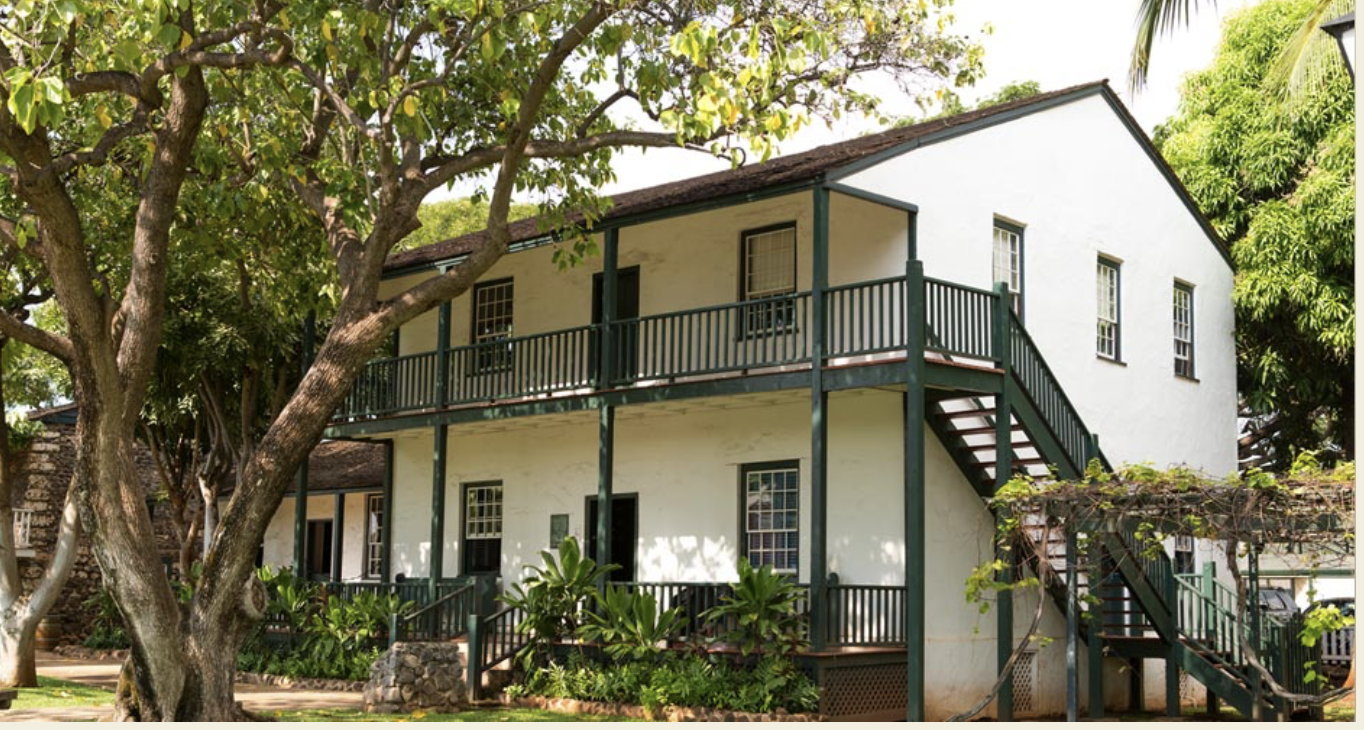
The Baldwin Home on Lahaina in Maui, Hawaii. Image via Lahaina Restoration Foundation.
Unfortunately, the Baldwin Home is one of many buildings that suffered extensive damage in the fire. The House had a wooden roof, which was completely burned by flames. The Baldwin Home Museum’s director, Theo Morrison, stated (shortly after the fire) that he suspected “the entire building was gutted.” This was later confirmed.
As more reports following the fire on Maui were released, damage to other precious cultural heritage sites on the island was to be expected. Reports – most tellingly, those from Native Hawaiians – revealed that cultural landmarks, art, and architecture crucial to the Hawaiian cultural narrative were destroyed. This includes sites on Lahaina were the first Hawaiian Constitution during the kingdom era was written in the 1800s, and an ancient fish pond where Hawaiian monarchs were known to take their rest and leisure.
Although Maui is often touted as a tourist site, for Native Hawaiians, it has been long-known as the heart of their storied history. In this light, the impact of cultural heritage lost by the wildfires points to the power and enduring influence of irreplaceable art, artifacts, and historic sites. The art community must look to ways to proactively prevent vulnerable pieces of cultural heritage from destruction by extreme natural weather events. The reality is that damage done to treasured works of art and cultural heritage anywhere causes the world to lose crucial components of shared human history.
Who’s to Blame?
As the world continues to reflect on the summer wildfires, many seek to find a scapegoat for the destruction. Climate change, arson, and inefficient government response teams have all been blamed. However, at this stage in the world’s evolution, pointing fingers does little to solve the problem at hand. Loss of delicate art and cultural heritage by natural disaster is part of the new normal. If art is to be preserved for future generations, proactive protection measures should be the first line of defense.
The second line of defense should be an increased awareness of the importance of preserving such heritage, and a place for that awareness in planning for orchestrated response efforts.
The third line of defense? It’s a call to individual action, and it comes from Smokey.
by Amineddoleh & Associates LLC | Sep 29, 2023 |
By: Maria T. Cannon
Due to the Azerbaijani regime’s military aggression last week, over 100,000 Armenians have fled the Republic of Artsakh (also called Nagorno Karabakh) in just four days. Azerbaijan’s military assault followed its nine-month-long illegal blockade of the entire region. For those Armenians who have called this land home (Artsakh became part of the Kingdom of Armenia in 189 BC and has maintained a majority Armenian population since then, despite being subjected to various invading rulers), fleeing their ancestral lands is necessary for survival. The alternative is to be subjected to the whims of a petro-dictatorship that openly conveys its formal policy of anti-Armenian hatred and belief that Armenians have “no right to live in the region.”
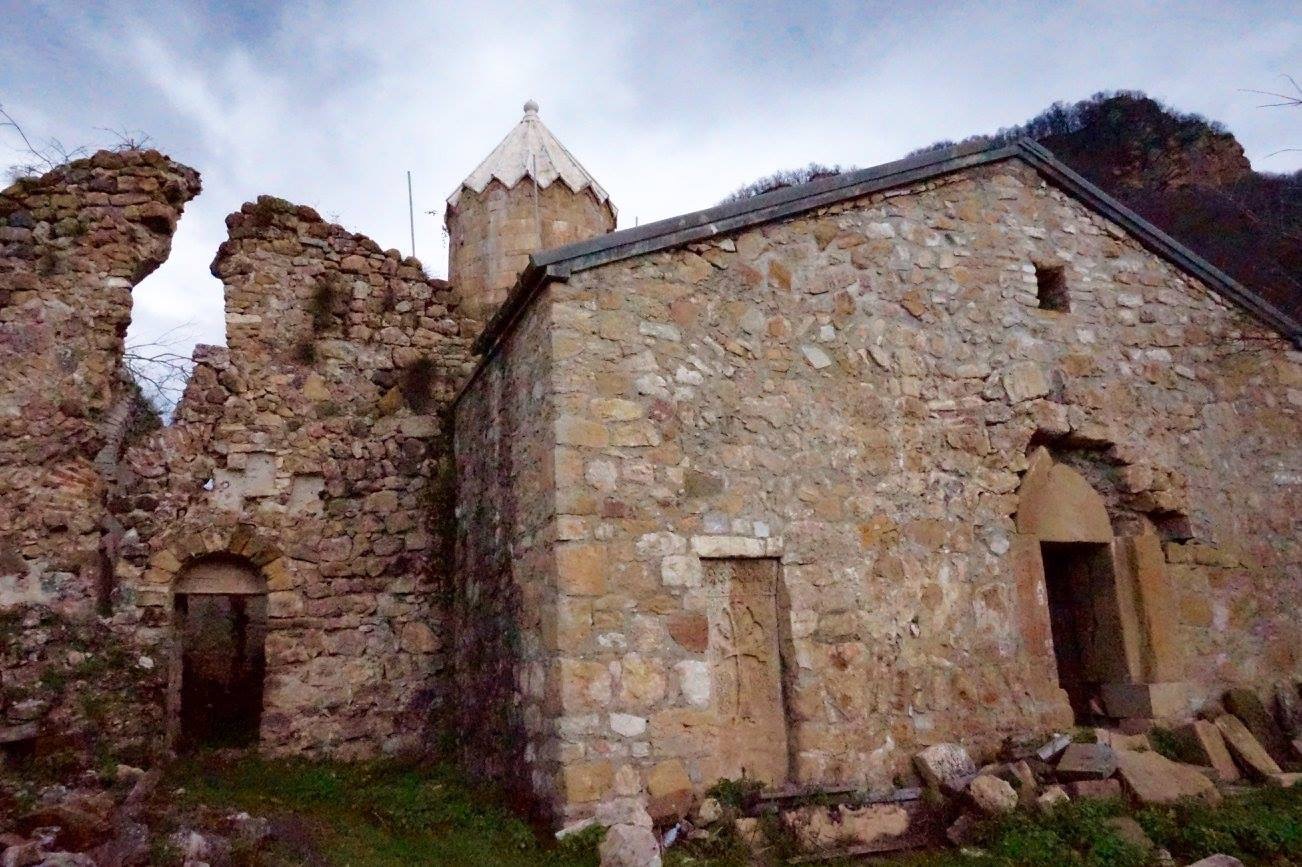
Gtichavank Monastery in Hadrut (2015). Used with permission from Yelena Ambartsumian.
Heartbreakingly, the exodus of Armenians and Azerbaijan’s occupation of the region leaves Armenian art and architecture unprotected, and we are already seeing videos of Azerbaijani soldiers shooting at and desecrating cultural heritage from Azerbaijani social media channels (international reporters are not able to access the region). Artsakh is known as the “Crown Jewel” of Armenian cultural heritage, as it contains some of the most exemplary representations of medieval Armenian architecture, as well as important sites such as the first school to teach the Armenian alphabet in the early fifth century.
War Crimes, Human Genocide & Cultural Genocide
It is a story well-known to regions in the throes of war: the searing pain of losing one’s home is compounded by the risk posed to cultural heritage left behind. In international law, war crimes, crimes against humanity, ethnic cleansing, and [human] genocide are defined separately from cultural genocide. However, all usually include acts of cultural genocide, due to the nature of the crimes committed.
Evidence of cultural genocide can be used to help prove the special intent required for the crime of genocide. This is largely because the two are so closely connected. In fact, modern experts urge legal professionals to understand that cultural genocide is “as old as [human] genocide itself” and may (in fact) be virtually inseparable from human genocide.
In light of the current situation in Armenia, and past actions by Azerbaijani forces in Artsakh— coupled with Azerbaijan’s complete eradication of over 100 medieval monasteries and thousands of cross-stones in its exclave of Nakhichevan during “peacetime”—it is an almost certainty that Azerbaijan will continue to destroy Armenian cultural heritage. Moreover, because global cultural heritage organizations such as UNESCO, have failed to uphold their own organizational standards, and other entities such as the EU have refused to condition their purchases of natural gas from Azerbaijan on Azerbaijan’s respect for cultural heritage, there is an even higher likelihood that Azerbaijan will continue to act with impunity.
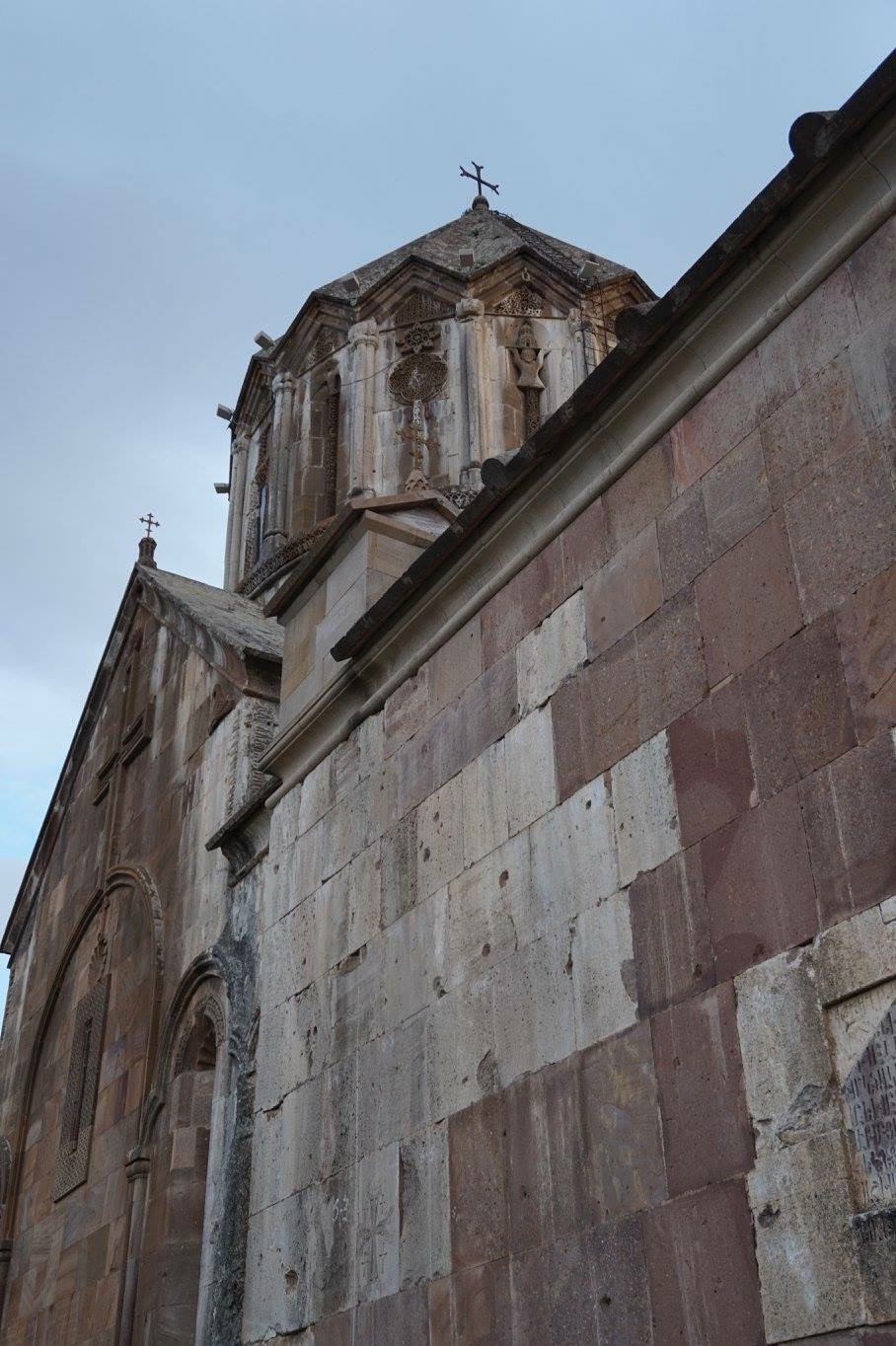
Gandzasar Monastery in Martakert (2015). Used with permission from Yelena Ambartsumian.
UNESCO’s Failure
UNESCO, known globally for championing world cultural heritage, has failed the Republic of Artsakh. On September 19, 2023, UNESCO launched a well-meaning (but utterly toothless) Armenia National Statement of Commitment Knowledge Hub and a similar Armenia National Consultation Report Knowledge Hub. The online portals come across as a futile attempt to maintain a presence in the real-life devastation currently unfolding. At this stage in the military regime’s progress, resources should be used to assist humanitarian and cultural preservation efforts on-the-ground—but Azerbaijan simply refuses to guarantee safe access to UNESCO monitors.
Both UNESCO’s current response and its lack of action in the months leading up to these (foreseeable) events are frustrating. Armenians have come to terms with UNESCO’s inability to protect their cultural heritage in this situation. The reasons UNESCO has been so ineffective are primarily two-fold: the first is the UNESCO’s Second Protocol lacks the enforcement mechanisms needed to (1) prevent cultural heritage destruction by states who are bad actors and (2) punish states that do. The disadvantages on relying on an organization such as UNESCO are compounded when the cultural heritage at issue resides in an area that UNESCO does not recognize as a “state.” The Republic of Artsakh falls under this category (meaning, UNESCO does not recognize it as a “state” of Armenia). UNESCO even failed to send a mere fact-finding mission to Artsakh, due to Azerbaijan’s objections.
The small crumb of good news is that the Armenian people took initiative and found a brilliant way to enforce global protection of their art and cultural heritage. As a law firm dedicated to protecting art and cultural heritage, we applaud the Republic of Armenia for developing this framework and precedent. We also are heartbroken that, as a nation, they were forced into developing this sort of legal path while a humanitarian crisis is currently ongoing.
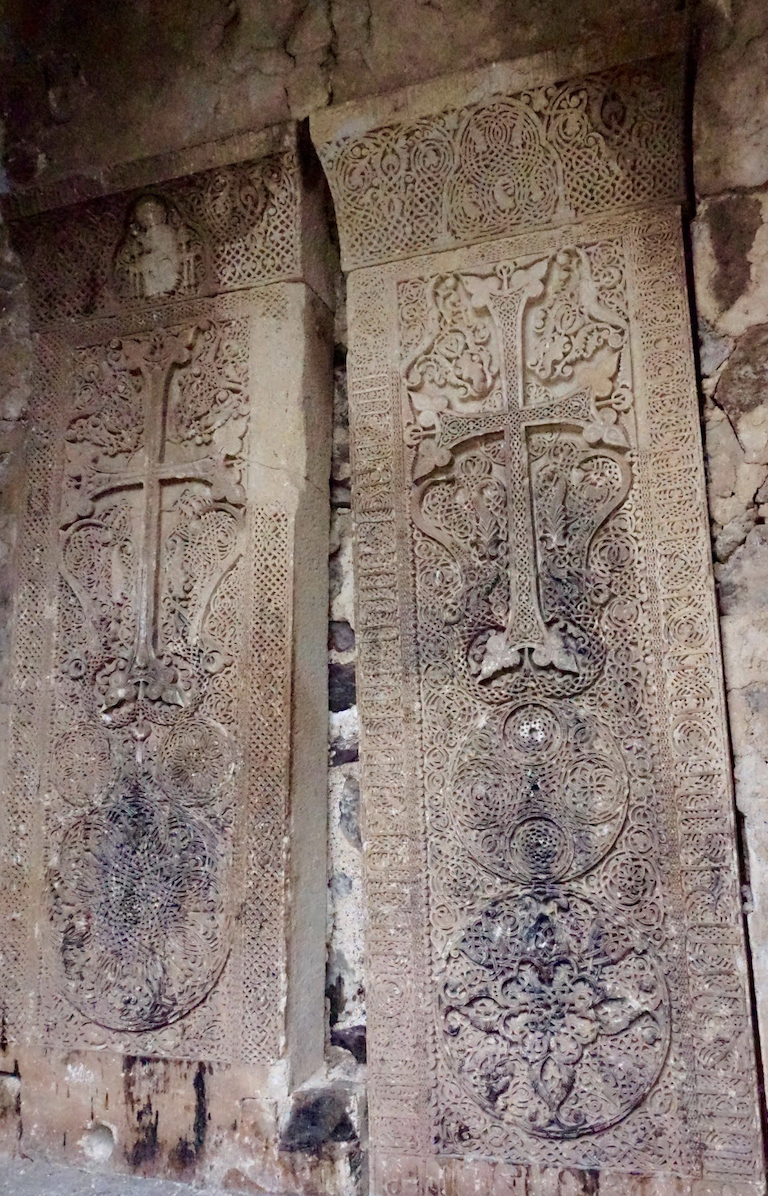
Dadivank’s khachkars (2015). Used with permission from Yelena Ambartsumian.
ICJ’s Decision and CERD
Instead of going through the UNESCO conventions, which inherently apply only to recognized states (and have therefore left out Armenian cultural heritage within the currently unrecognized Republic of Artsakh), Armenia instituted a case against Azerbaijan before the International Court of Justice (“ICJ”) under the CERD—the Convention on the Elimination of all Forms of Racial Discrimination—a United Nations treaty to which both Armenia and Azerbaijan are party.
The ICJ ruled for Armenia in its orders on provisional measures, stating that Azerbaijan must cease their state-sponsored destruction of Armenian art and cultural heritage in Artsakh.
With an ICJ order, which the U.N. Security Council is responsible for enforcing, the Republic of Armenia was able to create a new tool for safeguarding Armenian cultural heritage. Under Art. 94(2), member states are required to comply with ICJ orders. This means that Azerbaijan is clearly in violation. The U.N. Security Council has never before had to impose punishments (usually, simply the threat of involvement and diplomatic pressure from other nations are enough to stop the harm being done). However, in this case, action may not only be warranted, but is necessary to prevent Armenian culture from being erased from this region.
In an interesting update, the Republic of Armenia filed a request for indication of provisional measures against Azerbaijan, under the Armenia v. Azerbaijan proceedings before the ICJ on Sept. 29, 2023. In the filing, the Republic of Armenia specifically asked the Court to reaffirm Azerbaijan’s obligations under the Orders it rendered previously (stating, “in particular those of 7 December 2021 and 22 February 2023.“).
The importance of protecting the art and cultural heritage in Artsakh cannot be undermined. Why? Read on.
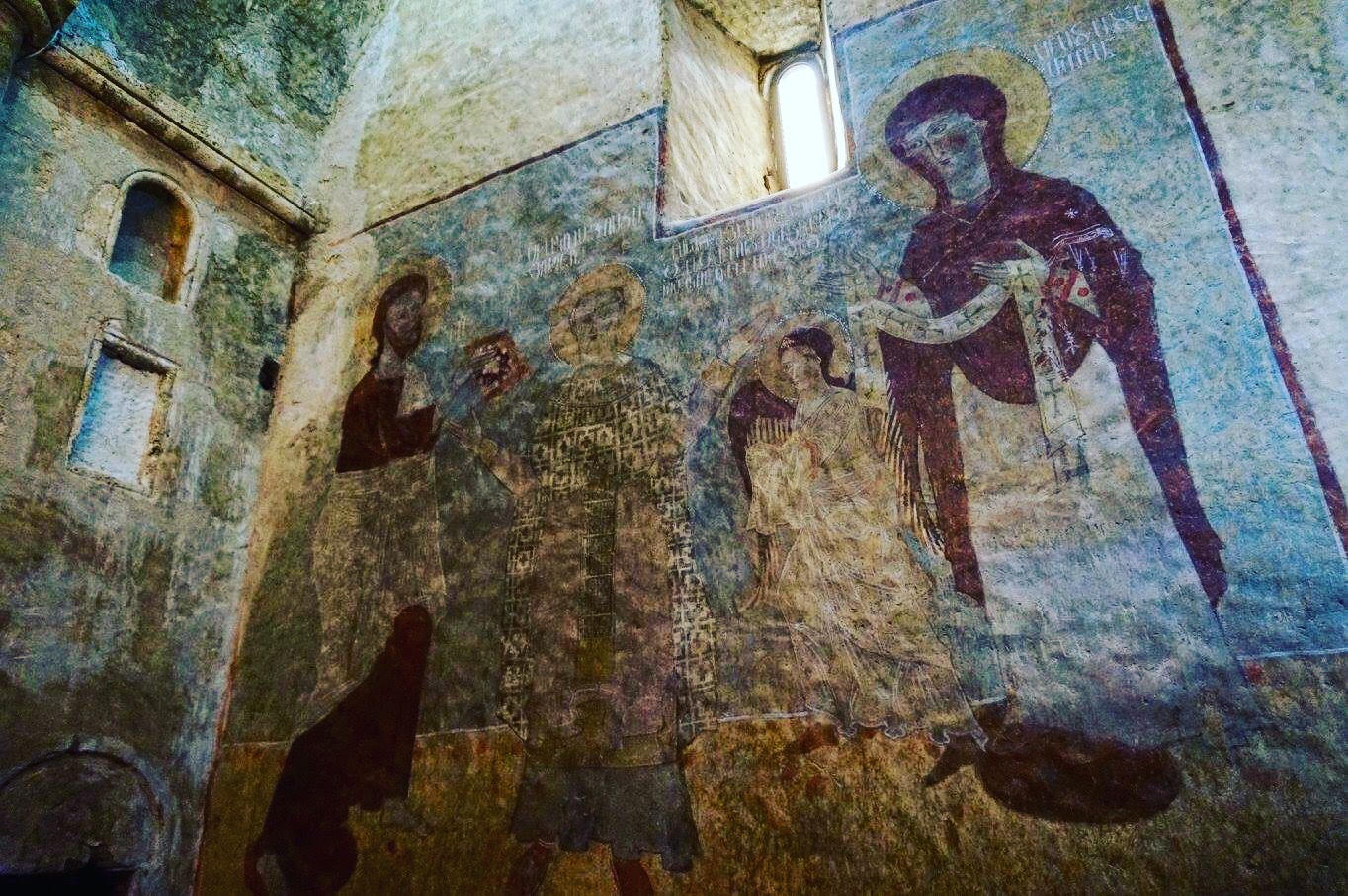
Fresco in Dadivank (2015). Used with permission from Yelena Ambartsumian.
Armenian Crown Jewels at Risk
Armenian cultural heritage has been under attack for some time. For evidence, turn to the fate of Armenian culture in the Caucasus under Azerbaijani occupation. Nearly all Armenian heritage sites in Nakhichevan were destroyed by Azerbaijan during “peacetime.” Satellite imagery by the Caucasus Heritage Watch from November 2022 confirmed that 98% of Armenian cultural sites were completely destroyed. Devastatingly, such annihilation was the result of state-sponsored, orchestrated destruction by Azerbaijani officers. To date, Azerbaijan denies destruction and instead claims that Armenian cultural heritage never existed in Nakhichevan.
Artsakh’s treasures are incredibly vulnerable in light of recent aggression by Azerbaijani forces. This is devastating to the Armenian and global artistic, religious, and historical academic communities, because Artsakh is referred to as the crown jewels of Armenian culture due to the massive number of sites from antiquity to the medieval ages, as well as cave complexes with some of the earliest evidence and remains of various hominid species in Eurasia (after crossing from Africa). In addition to having ties to Armenian nobility, the art, artifacts, and architecture in Artsakh are vital to understanding and appreciating Armenian culture. Armenians themselves reported emphasize the significance of Artsakh by saying, “after all, the crown of the ancient Kingdom of Armenia is in Nagorno-Karabakh [Artsakh].”
The entire region presents a stunning encapsulation of Armenia’s art and history. Early historical monuments and ancient fortresses reflect pre-Christian influences, while later expressions such as illuminated manuscripts, ecclesiastical murals, cross-stones, and religious structures embody the heritage of one of the world’s oldest, indigenous Christian populations. Below are two specific Armenian cultural crown jewels, currently under attack.
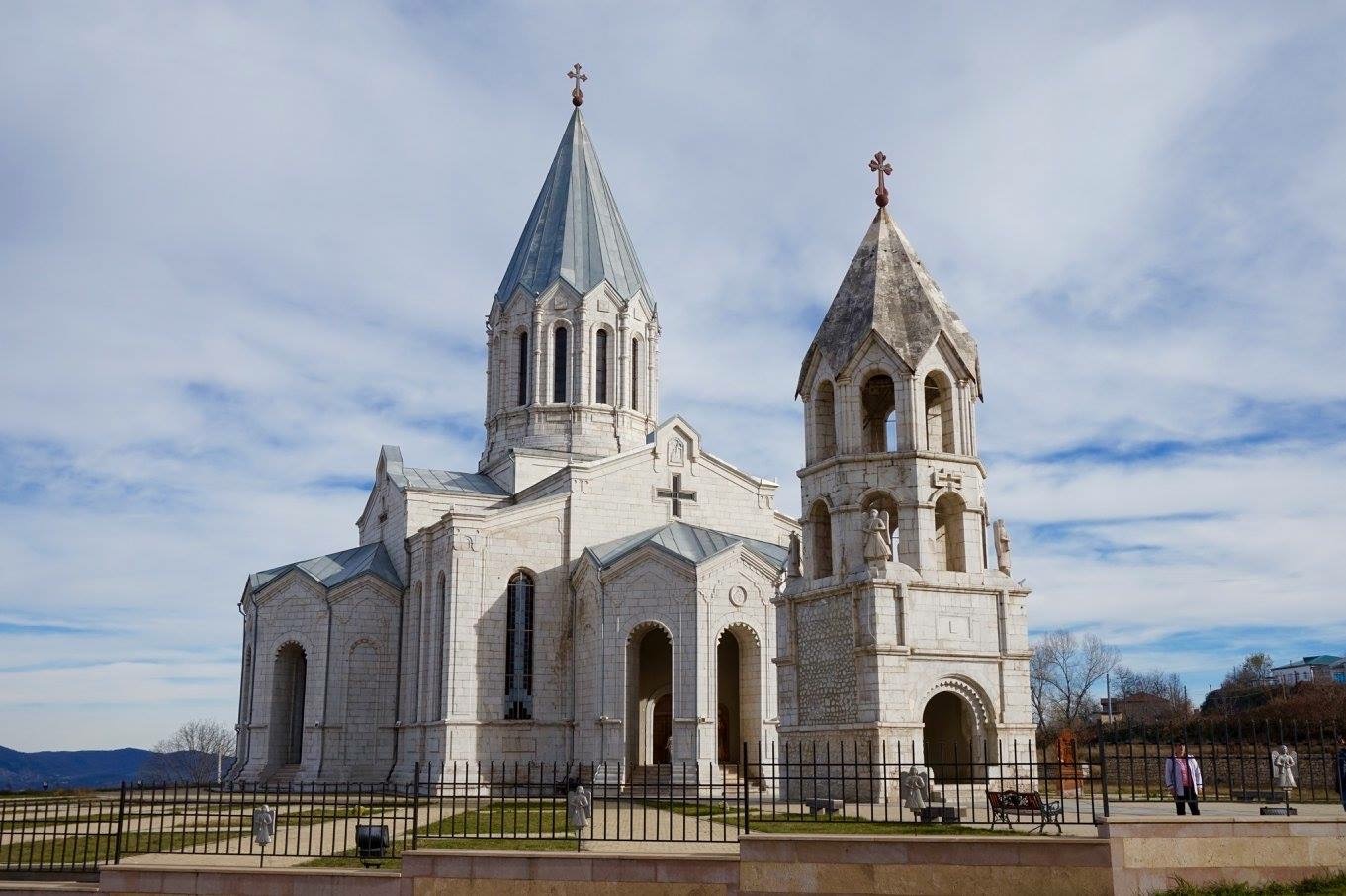
Ghazanchetsots Cathedral in Shushi (2015). Used with permission from Yelena Ambartsumian.
Shushi
The city of Shushi, in Nagorno-Karabakh, is a true Armenian cultural crown jewel. Shushi came under occupation by Azerbaijan in November 2020. Before and after gaining control of Shushi, Azerbaijan intentionally attacked its Armenian cultural heritage. In fact, in October 2020, it shelled the beautiful Ghazanchetsots Cathedral not once, but twice. There was no evidence that the shelling qualified as a military objective, particularly as civilians were hiding in the church (and the second shelling occurred when international journalists arrived to cover the destruction —one journalist was killed).
Ensuing coverage of the cathedral revealed graffiti on the walls, with Azerbaijani leaders marching through the sacred space. Precious manuscripts and relics, such as the Right Arm of Grigoris—the Catholicos of the region and grandson of St. Gregory the Illuminator who
converted Armenia to Christianity in the early 300s—are feared to be lost.
Azerbaijan then began its own “renovation” of the cathedral (deemed by the Azerbaijani Ambassador to the Holy See Ilgar Mukhtarov as a corrective effort to return the cathedral to “its original appearance [prior to Armenian cultural influence.]” This “renovation” was not done in consultation with the Armenian Apostolic Church and instead involved “beheading” the cathedral by removing its pointed dome—a hallmark of Armenian church architecture. Azerbaijan also destroyed another church in Shushi—the “Kanach Zham” (Green Chapel) Armenian Church of St. John the Baptist—by removing its pointed cupola.
The devastation is reminiscent of proto-Azerbaijani armed forces’ destruction of Shushi in 1920, which were supported by the Ottoman Army, as it marched eastward to try to take control of the region amidst the Armenian Genocide. At that time, the Ghazanchetsots was also targeted and vandalized, in addition to other significant Armenian cultural heritage sites. Half of Shushi was revealed to be destroyed, as the unrecognized Azerbaijan Democratic Republic carried out a “cultural de-Armenianization” of Nagorno-Karabakh. Current reports and photos of the region now under occupation prove that the cultural jewels of the city are – once again – suffering intentional destruction at the hands of Azerbaijani military forces.
Dadivank
Dadivank is another important cultural jewel that has fallen under Azerbaijani occupation. This is an unprecedented loss, as the Dadivank region is a spiritual center for Armenian Christians. Dadivank contains an important religious complex, known as the Dadivank Monastery, which houses the relics of St. Dadi, a disciple of Thaddeaus the Apostle, in addition to other sacred artifacts and objects. Because the land is now under Azerbaijani control, irreplaceable symbols of Armenian spiritual and religious heritage are in danger.
The monastery itself encompasses a series of more than thirty buildings on its territory. This includes several churches, chapels, monasteries, libraries, and living quarters, as well as the Hasan-Jalal Palace (and even a printing press!). Cultural highlights include works such as the frescos on the walls of the Church of the Holy Virgin (built in 1214 by Princess Arzu-Khatan, and the porch-chapel of St. Grigor (built in 1224 as the burial vault of princes).
Another priceless piece of Armenian cultural heritage is located on these grounds: khachkars, or cross-stones (stone slabs with engraved crosses). These are irreplaceable components of the Armenians’ cultural legacy, because they are exclusive to Armenian religious art (and have been for centuries). Many of the khachkars located in the St. Dadi Church, for example, date back to the 12th and 13th centuries. Unfortunately, because these works are so closely tied to Armenian Apostolic Church identity, khachkars and other works of ecclesiastical art and architecture are prime targets for Azerbaijani destruction.
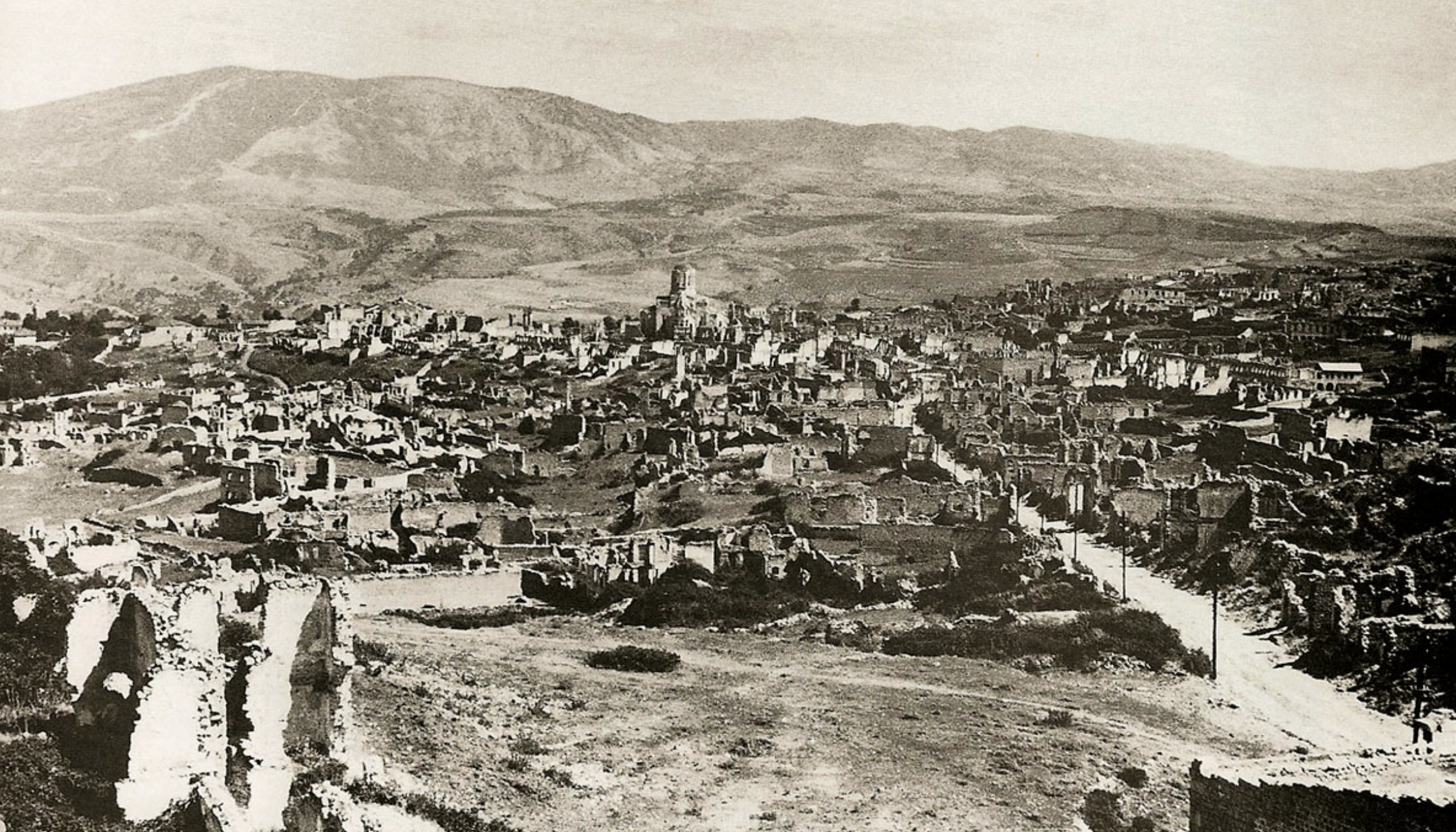
Ruins of Shushi after the city’s destruction by Azerbaijani army in March 1920. In the center: defaced Armenian Ghazanchetsots Cathedral. Image via State Archives of Armenia (public domain).
Global Response
Armenians who have been able to flee recount the bombing, fear and death they have left behind. Their first-person accounts give us a clearer insight as to what is truly going on in Artsakh – both to ethnic Armenians and to their cultural and artistic treasures. Reports of attacks done with “no apparent regard for the lives or basic human rights of the population of Nagorno-Karabakh” explain the seriousness of the situation.
Armenian art and architecture carry incredible significance – not just in Armenian culture, but as a vital piece of our shared global human narrative. The works being destroyed are testaments to their artistic mediums – gorgeously decorated and elaborately intricate. More importantly, they are symbols of the history of Armenia as a liberated people.
Many of these cultural heritage sites have served as pilgrimage destinations for Armenians for centuries. Even apart from the significance to Armenian culture, the sacred works and spaces are a testament to pre-Christian medieval influences, early Christian artistic works, and the 19th and 20th century religious-cultural renaissance of the region.
All can do their part in raising awareness of the on-going crisis in Armenia. In addition to continuing to pressure government officials to take action, make a donation through a trusted relief organization.
Donate to the Armenian Red Cross here.
by Amineddoleh & Associates LLC | Sep 29, 2023 |
 Our founder, Leila Amineddoleh, has recently been featured in New York Metro Super Lawyers Magazine, alongside other leaders in her field. Leila was chosen for the piece as a top-rated intellectual property, art, and cultural heritage lawyer well-known in the industry for getting the job done right. This means advocating both for her clients, and for the art and cultural heritage at issue.
Our founder, Leila Amineddoleh, has recently been featured in New York Metro Super Lawyers Magazine, alongside other leaders in her field. Leila was chosen for the piece as a top-rated intellectual property, art, and cultural heritage lawyer well-known in the industry for getting the job done right. This means advocating both for her clients, and for the art and cultural heritage at issue.
In the article, Leila’s experience working with our former client (and now current friend) Laura Young, is highlighted. Young is our client who found an Ancient Roman marble bust at her local Goodwill in Austin, TX. Our firm has written previously about Leila’s and Laura’s story. Read the incredible journey one Roman bust took from Germany to Texas (and how he found his way home) here.
In the piece by Super Lawyers, Leila’s success working with Laura is illustrative of her signature manner taking care of her clients by providing insight on best practices in the art law field. In Leila’s words, her work as a lawyer requires giving this special level of attention. She says it can require coming up with “creative solutions . . . . As a lawyer, you find out what’s important to someone.”
Later in the article, Leila gives her thoughts on changing attitudes on lawsuits involving stolen antiquities. She connects the rise of modern lawsuits brought by claimants for contested works to a 1995 international investigation in Italy. That investigation exposed many thought-to-be honest dealers as thieves, and revealed and auction houses to be engaging in deceptive practices. Leila explains how the impact of this investigation continues to call objects held by museums, collectors and auction houses into question, leading to an on-going return of hundreds of objects and works of art.
Leila’s success has launched her and her namesake firm to even greater heights. It is an honor to be featured alongside other esteemed colleagues this stand-alone piece. In it, Leila and her colleagues give important guidance on the current industry challenges for art lawyers. Read the piece here.
by Amineddoleh & Associates LLC | Dec 14, 2022 |
In this annual newsletter, Amineddoleh & Associates is pleased to share some major developments that took place at the firm and in the art world during 2022.
LITIGATION AND SETTLEMENT UPDATES
The “Goodwill” Marble Bust

The Marble Bust looted during WWII that was found in Texas and will be returned to Germany
Possibly the most talked about art law matter of the year was the return of an ancient marble bust to Germany. The 2,000-year-old artifact likely originated from Rome, but it was acquired by Bavarian King Ludwig I and then placed in a German museum from where it was looted during World War II. Our client, Laura Young, bought it at a local goodwill shop and ultimately returned it to Germany. It was an honor to advise her and work with her to negotiate the internationally celebrated return.
Copyright Infringement Lawsuit
At the start of the year, we filed a litigation in Iowa on behalf of a muralist, Chris Williams. His work was featured in an advertisement that aired during the Super Bowl. We are currently representing him in a lawsuit for copyright and a violation of his moral rights on the Visual Artists Rights Act.
ART & IP NEWS
One of our favorite things about the art market is that there is always something exciting happening in the art world. Some of our most popular blog posts from this year are found below.
Celebrities and Fossil Collecting

Skeletons in the American Museum of Natural History
In this blog post, our firm examined legal matters involving dinosaur fossils and skeletons, including purchases made by Nicolas Cage, Leonardo DiCaprio, and The Rock. Auction houses have faced growing interest in buyers seeking dinosaur bones. The sales have gotten a lot of attention, perhaps due to the trend of major celebrities making large, public bids for the pieces. As a result of the publicity, countries around the world from which fossils are illegally excavated have presented auction houses with ownership claims, based on their country’s property laws. Copyright law was also an issue for auction houses selling dinosaur skeletons this year because skeletons that are partly comprised of replica bones may come with intellectual property rights in the manufactured pieces.
Fashion Law and Protecting Brands
 When does the law protect fashion brands? And what is the cost to other artists? Our firm answered these questions in this posts inspired by the Fall 2022 Fashion Weeks taking place around the world. Prominent fashion designers have been known to incorporate logos of other brands into their designs, often as a part of social commentary. Even where artistry is the intent behind the repurposed logo, these designers face financially devastating intellectual property claims from major the brands and companies who own the rights to the logo. Our firm considered how to balance protecting consumers from consumer confusion with giving designers the artistic liberty to create fashion that sparks social commentary. Read more on our website.
When does the law protect fashion brands? And what is the cost to other artists? Our firm answered these questions in this posts inspired by the Fall 2022 Fashion Weeks taking place around the world. Prominent fashion designers have been known to incorporate logos of other brands into their designs, often as a part of social commentary. Even where artistry is the intent behind the repurposed logo, these designers face financially devastating intellectual property claims from major the brands and companies who own the rights to the logo. Our firm considered how to balance protecting consumers from consumer confusion with giving designers the artistic liberty to create fashion that sparks social commentary. Read more on our website.
New York Raises Holocaust Awareness Through New Law

Gustav Klimt’s Woman in Gold
New York State now requires museums to post which artworks on display have links to the Holocaust. The New York bill, which was signed into law on August 10, 2022, accompanied two other Holocaust related bills aimed to combat rising reports of antisemitism. Our firm revisited the difficulty of proving provenance for items acquired during the Holocaust and shortly following WWII. The restitution of these works to families from which the pieces were stolen is incredibly healing.Unfortunately, such claims for the return of priceless works of art often have to overcome enormous legal hurdles, such as the difficulty of proving provenance in court and FSIA claims brought by countries who now claim possession. Read more on our website.
LAW FIRM UPDATES AND EVENTS
New Team Members
Our firm welcomed two new members to join our team, Yelena Ambartsumian and Maria Cannon. Yelena joins the firm as Counsel, while Maria joins us as an associate. We are proud to have Yelena and Maria as members of our team, and we wish them both a warm welcome.
Firm Founder Listed by Chambers
This year, firm founder Leila A. Amineddoleh was recognized by Chambers and Partners High Net Worth Guide for her work in Art and Cultural Property Law. The publication named Leila “a brilliant attorney,” and “a go-to for cultural property matters.” The publication also remarked on her passion for art law and her wealth of experience in the field. Read more here.
Art Law Conferences
Congratulations to our firm’s founder Leila A. Amineddoleh, who successfully chaired the 14th Annual NYCLA Art Law Institute, one of the most anticipated events of the year. Earlier in the year, in March, Leila presented the keynote speech at Yale University’s conference “Dura-Europos: Past, Present, and Future.” The conference focused on the systematic looting of Dura-Europos that took place during the Syrian civil war and during prior millennia. Leila presented on the history of cultural heritage looting and modern efforts to prevent such plunder. Read more about the conference here.
Leila was also a speaker at the Salmagundi Club, one of the oldest arts organizations in the U.S. Her other speaking engagements included moderating a panel for Art Appraisers’ Association Art Law Day and for Fordham’s Intellectual Property Law Journal’s 30th Annual Symposium, “Duplicate, Decolonize, Destroy: Current Topics in Art and Cultural Heritage Law.” In addition, she spoke at conferences hosted by Cardozo School of Law and Notre Dame School of Law. At Cardozo School of Law, Leila spoke on a panel at a symposium discussing cultural property ownership. Read more here. At Notre Dame’s Journal of International and Comparative Law Symposium, she served as panelist at the symposium, “International and Comparative Approaches to Culture”, and discussed antiquities disputes and repatriation of cultural heritage.
Associate Claudia Quinones presented on the “What’s New in Art Law?” panel at the 14th Annual NYCLA Art Law Institute. Her presentation covered title and ownership disputes, new technologies, and climate change activism in the art world. Details about the conference can be found here.
Yelena’s speaking engagements included Fordham Law School’s 30th Annual Intellectual Property Law Journal Symposium as a panelist on “Erased: Protecting Cultural Heritage in Times of Armed Conflict.” She also was a panelist at American University of Armenia’s Center for Truth and Justice Inaugural International Conference, “Cultural Heritage at Stake: How to Preserve, Mitigate Damage, and Punish Destruction.” Read more about the conference here.
IN THE PRESS
Leila appeared in the New York Times a number of times this year, in addition to Artnet, The Art Newspaper, the Observer, the Washington Post, USA Today, People Magazine, and Town + Country Magazine. She discussed a variety of topics, including the art market, cultural heritage disputes, Nazi-looted art, intellectual property disputes, and art collecting practices. Leila also appeared on WPIX-NY and in a number of podcasts.
CLIENTS AND REPRESENTATIVE MATTERS
Sculpture Garden Commission at the Smithsonian Institution
We are very proud to have served as legal counsel to famed artist Hiroshi Sugimoto for a number of his commissions, including his highly anticipated sculpture garden at the Hirshhorn Museum, part of the Smithsonian Institution.
 Auction Sales
Auction Sales
We worked with a number of clients to assist them with consigning art for sale at auction. One of our clients is the collecting family that consigned three works by David Hammons for the Sotheby’s Contemporary Evening Auction and one work at the Contemporary Curated sale earlier in the spring. Sotheby’s touted these works and their provenance, after the paintings remained with our clients for nearly five decades. All four of the works performed well, with two of them selling for above their high estimates.
Trademark Clients
We continue working with brands, artists, and companies by advising and serving as trademark prosecutors. Included among our clients are luxury watch brands, fragrance companies, and musicians, including multi-platinum songwriter and produced Jonas Jeberg.
Advising Art Market Players on New Platforms
While we often work with traditional art market participants (including artists, collectors, foundations, auction houses, museums, art advisors, and art experts), we are also happy to be at the forefront of the art and cultural world. As new art platforms and technologies develop, we are pleased to work with exciting online galleries, NFT platforms, novel art collecting exchanges, and artists exploring new media. We look forward to continue cutting edge work in the art sector.
On behalf of Amineddoleh & Associates, we wish you a happy and healthy holiday season and a wonderful and prosperous new year.
by Amineddoleh & Associates LLC | Nov 20, 2020 |

Golden Coffin of Nedjemankh– looted from Egypt and sold with false provenance
The Victoria & Albert Museum in London is currently closed, but it continues to create and distribute valuable content examining issues related to art and heritage looting. Through Culture in Crisis, a program bringing together individuals and organizations with a shared interest in protecting cultural heritage, the museum is actively engaging with heritage professionals to provide insights into the dangers facing our shared history. One tool for raising awareness of these issues is the Culture in Crisis Podcast.
Season Two, Fighting the Illicit Trade, is comprised of interviews with international experts working to prevent the illegal trade of cultural heritage– each person fighting a battle to rescue cultural heritage at a different stage of its underground journey. The series examines the actions taken at the object’s source, through transit, and upon arrival at its destination. As stated by Culture in Crisis, “The theft and sale of cultural property robs communities of their past, present and future. It lines the pockets of international criminal networks and has been shown to directly finance terrorism. Through this series we hope to highlight valuable initiatives working to prevent the illicit trade and gather recommendations on how to build on these efforts in the future.”
Our founder, Leila A. Amineddoleh, is interviewed in Episode 7, “You’ve Gotta Have (Good) Faith.” She offers a legal perspective about heritage looting, discussing legal cases, provenance (including false provenances), good faith purchases, and the due diligence involved in purchasing antiquities. Read more about the series and listen to the informative interviews here.











 Our founder, Leila Amineddoleh, has recently been featured in New York Metro Super Lawyers Magazine, alongside other leaders in her field. Leila was chosen for the piece as a top-rated intellectual property, art, and cultural heritage lawyer well-known in the industry for getting the job done right. This means advocating both for her clients, and for the art and cultural heritage at issue.
Our founder, Leila Amineddoleh, has recently been featured in New York Metro Super Lawyers Magazine, alongside other leaders in her field. Leila was chosen for the piece as a top-rated intellectual property, art, and cultural heritage lawyer well-known in the industry for getting the job done right. This means advocating both for her clients, and for the art and cultural heritage at issue.

 When does the law protect fashion brands? And what is the cost to other artists? Our firm answered these questions in this posts inspired by the Fall 2022 Fashion Weeks taking place around the world. Prominent fashion designers have been known to incorporate logos of other brands into their designs, often as a part of social commentary. Even where artistry is the intent behind the repurposed logo, these designers face financially devastating intellectual property claims from major the brands and companies who own the rights to the logo. Our firm considered how to balance protecting consumers from consumer confusion with giving designers the artistic liberty to create fashion that sparks social commentary. Read more on our
When does the law protect fashion brands? And what is the cost to other artists? Our firm answered these questions in this posts inspired by the Fall 2022 Fashion Weeks taking place around the world. Prominent fashion designers have been known to incorporate logos of other brands into their designs, often as a part of social commentary. Even where artistry is the intent behind the repurposed logo, these designers face financially devastating intellectual property claims from major the brands and companies who own the rights to the logo. Our firm considered how to balance protecting consumers from consumer confusion with giving designers the artistic liberty to create fashion that sparks social commentary. Read more on our 

 Auction Sales
Auction Sales